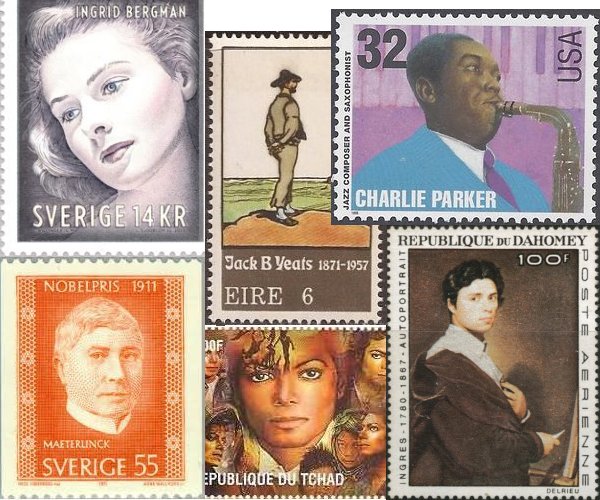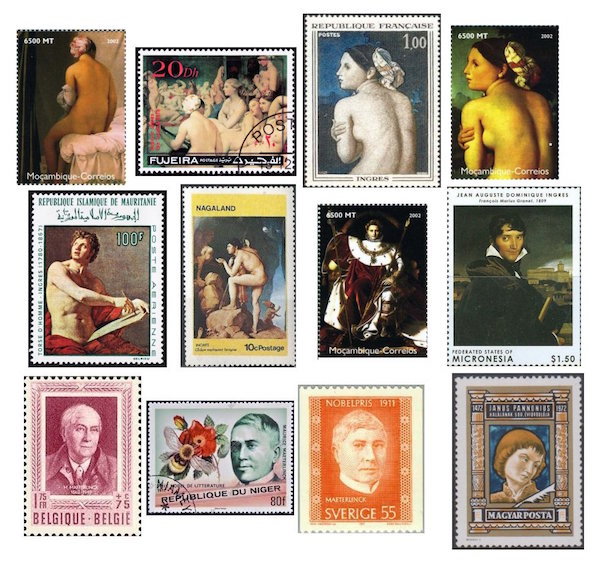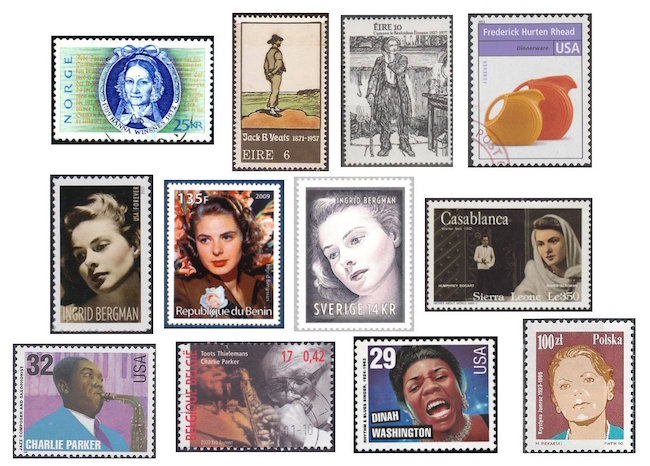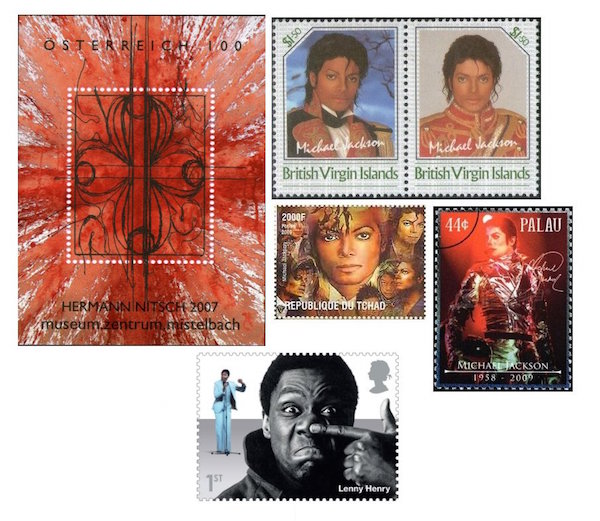The Arts on Stamps of the World — August 29
An Arts Fuse regular feature: the arts on stamps of the world.

By Doug Briscoe
Our three most famous names for today are Ingrid Bergman, Charlie Parker, and Michael Jackson, and from painting and literature we offer two more superlative artists, Ingres and Maeterlinck.
For the fourth consecutive day our first collage is devoted to a single person. Today it’s the great French Neoclassical painter Jean-Auguste-Dominique Ingres (29 August 1780 – 14 January 1867). Given that I confessed the other day to a passionate love of the Pre-Raphaelites, you won’t be surprised to learn that I also adore the work of Ingres. We begin with his Self-Portrait (1804, revised c1850) as seen on two stamps, one from Dahomey and the other from Russia. On the latter the portrait is juxtaposed to one of Ingres’ most beloved paintings, The Source (1856), which also shows up on stamps of Monaco and Mozambique. In the second row are two versions of La Grande Odalisque (1814) and a detail from Paolo and Francesca (1819), taken from a Togolese minisheet. Also on stamps of Togo (third row) are a detail from Roger Delivering Angelica (1819) and Jupiter and Thetis (1811). Next to them we come upon Portrait of Mademoiselle Rivière (1805, Paraguayan stamp) and a detail from one of Ingres’ later works, Jesus Among the Doctors (1862, stamp from Niger). At the top of the second collage we see Ingres borrowing from himself a bit, the Grand Baigneuse (also called The Valpinçon Bather) of 1808 having been reused almost unchanged more than half a century later in The Turkish Bath (1862-63). A similar concept is found in The Bather (1807) on stamps of France and Mozambique. The final row of Ingres stamps offers Academic Study of a Male Torso (1801, stamp from Mauritania), Oedipus and the Sphinx (1808), Napoleon on His Imperial Throne (1806), and Portrait of François-Marius Granet (1807, stamp of Micronesia). Before we leave Ingres, I want to bring up a couple of additional points of interest. He made drawings or paintings of three composers of the day, Paganini (1819), Liszt (1839), and Cherubini (1842). Do you remember a 1955 Fritz Lang swashbuckler called Moonfleet, with Stewart Granger, George Sanders, and Joan Greenwood? or a 1956 film called The Spanish Gardener, with Dirk Bogarde and Michael Hordern? Both pictures featured a child actor named Jon Whiteley. Here he was then, and here he is now. The point? Whiteley grew up to become a distinguished art historian affiliated with the Ashmolean Museum at Oxford for many years, and one of his books is Ingres (Oresko Books, 1977). I own a copy. Oh, one more thing: tomorrow is the birthday of another great French Romantic painter: Jacques-Louis David.

Also born on this day was the Belgian playwright Maurice Maeterlinck (1862 – 6 May 1949), whose Pelléas and Mélisande (1892) inspired an opera by Debussy, a symphonic poem by Schoenberg, incidental music by Sibelius, and suites by Fauré and William Wallace, all in the space of less than a decade (1897–1905). Some other musical works of note after Maeterlinck include the opera Ariane et Barbe-bleue (Ariadne and Bluebeard) by Dukas; incidental music by Ralph Vaughan Williams and a symphonic poem by Charles Martin Loeffler for La Mort de Tintagiles (The Death of Tintagiles); unfinished operas by Rachmaninov and Lili Boulanger (whose birthday we just acknowledged eight days ago), along with many other poetry settings by such composers as Chausson, Zemlinsky, Respighi, and Ibert. Maeterlinck was awarded the Nobel Prize for literature in 1911.

Regarded as the most important poet in the Renaissance Kingdom of Hungary, Janus Pannonius (29 August 1434 – 27 March 1472) was a Croatian-Hungarian humanist. The Croatian variant of his name is Ivan Česmički, and the Hungarian János Csezmiczei (or Kesencei). Educated in Italy, at Ferrara and Padua, and recognized for his intellectual powers, he started writing poetry when he was about thirteen. He served as court poet (also as a diplomat) to Hungarian King Matthias Corvinus and was elevated to the position of Bishop of Pécs. He subsequently conspired against Matthias, whose authoritarian rule he opposed, but on the failure of the enterprise he fled to Croatia and died there, aged 38.
Considered the first female novelist in Norway, Hanna Winsnes (29 August 1789 – 19 October 1872) also wrote poetry, a children’s book, and a cookbook (actually a Guide to the Various Branches of Housekeeping, 1845, but with many recipes). Her earlier works were written under the pseudonym Hugo Schwartz.
The brother of William Butler Yeats was the painter Jack Butler Yeats (29 August 1871 – 28 March 1957). Their father, John Butler Yeats (16 March 1839 – 3 February 1922), was also a painter. Jack is viewed as one of the finest Irish painters of the 20th century, and he also wrote a number of plays and novels, one of which in particular, The Amaranthers (1936), was much admired by his good friend Samuel Beckett. Another friend, whose style of painting, Butler’s resembles, was Oskar Kokoschka. Two of Jack’s works are reproduced on stamps of Ireland: the first, “An island man”, was created to be the frontispiece illustration for John M. Synge’s nonfiction book The Aran Islands (1907), and the second is entitled The Shanachie.
English-born Frederick Hurten Rhead (29 August 1880 – 2 November 1942) was a potter who lived and worked most of his life in the United States. He settled in Ohio when he came over in 1902. In 1911 he removed to California and started his own studio in Santa Barbara a couple of years later. Rhead lived in West Virginia from 1927. His most successful line of ceramics was the Fiesta line of dinnerware he developed in the late 1930s. It figures on one of the stamps issued to commemorate American design in 2011.

The unforgettable Ingrid Bergman (29 August 1915 – 29 August 1982) was remembered on a US stamp just two years ago. She’s also on recent issues from Benin and her native Sweden. In addition, I reprise the Sierra Leonian Casablanca stamp we just saw the other day to commemorate the birthday of the Epstein brothers Julius & Philip.
I’m an ignoramus when it comes to jazz, but even I know that Charlie Parker (August 29, 1920 – March 12, 1955) was one of the greatest voices in the genre. He was born and raised in Kansas Cities (both of them, sequentially), and began playing sax at 11. He devoted himself to intensive practice and joined Jay McShann’s band in 1938, but an automobile accident left him addicted to morphine and then cocaine for the rest of his short life. An innovator with a searching mind, Parker was one of the key contributors to the advent of bebop and investigated what would come to be known as Third Stream, even making a record with classical string musicians. The nickname “Bird” was chosen for the 1988 Clint Eastwood film in which Parker was played by Forest Whitaker. In addition to the US stamp from 1995, Belgium issued on pairing Parker with Toots Thielemans.
Four years younger than Bird to the day was jazz singer and pianist Dinah Washington (August 29, 1924 – December 14, 1963), who, though called “Queen of the Blues” also performed R&B and in other popular styles. She was born Ruth Lee Jones in Alabama and moved to Chicago in childhood. In the early days she worked with Fats Waller and Lionel Hampton. She enjoyed a number of top ten hits between 1959 and 1961. But her life, like Parker’s, was cut short by drugs; she succumbed to a combination of secobarbital and amobarbital at age 39. Her stamp was an earlier entry, from 1993, in the extended American Music series that later honored Parker.
August 29 is the birthday of Polish dramatic soprano Krystyna Jamroz (YAHM-ross; 1923 – 19 July 1986). Following her debut as the page in Rigoletto in Wrocław in 1948, she had a distinguished career in her native country, but I’m not able to learn much more about her online. A Krystyna Jamroz International Music Festival has been held in Busko-Zdroj since 1995.

The Austrian Hermann Nitsch (born 29 August 1938) does experimental art, “splatter” paintings, multimedia, performance art, that sort of thing. Usually there’s a lot of blood and a little nudity involved. Central to his work was a series called The Orgiastic Mystery Theater, conceived in the 1950s and realized in a hundred performances between 1962 and 1998. Accused of blasphemy and other things, he has been sentenced to brief prison terms on three occasions. But somebody must think he’s OK, because Austria issued a small souvenir sheet with his work on it in 2007.
Superstar of superstars, entertainer Michael Jackson (August 29, 1958 – June 25, 2009) would have been 59 today. Of the many foreign stamp issues in his honor, I selected a few from the British Virgin Islands, Chad, and Palau. I’ll be very surprised if he doesn’t show up on an American issue sooner or later.
Born on exactly the same day as Michael Jackson was another black entertainer, English stand-up comic Lenny Henry (Sir Lenworth George Henry, I’ll have you know). Born in Worcestershire to parents from Jamaica, he was already on TV before he was out of his teens. He imitated British television and radio personalities and earned his own show in 1984. The Lenny Henry Show ran until 1988 and was twice revived. He began acting in films in the 90s and received accolades for his 2009 stage performances as Othello.
A graduate of the University of Massachusetts with a B.A. in English, Doug Briscoe worked in Boston classical music radio, at WCRB, WGBH, and WBUR, for about 25 years, beginning in 1977. He has the curious distinction of having succeeded Robert J. Lurtsema twice, first as host of WGBH’s weekday morning classical music program in 1993, then as host of the weekend program when Robert J.’s health failed in 2000. Doug also wrote liner notes for several of the late Gunther Schuller’s GM Recordings releases as well as program notes for the Boston Classical Orchestra. For the past few years he’s been posting a Facebook “blog” of classical music on stamps of the world, which has now been expanded to encompass all the arts for The Arts Fuse.
